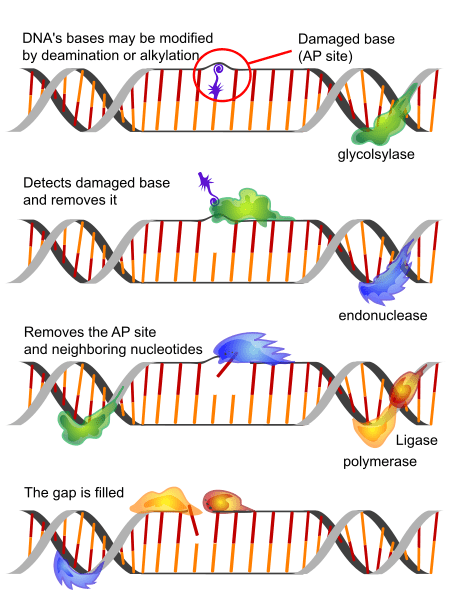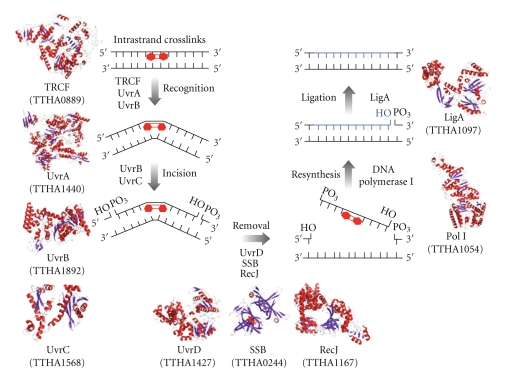Difference Between Base Excision Repair and Nucleotide Excision Repair
Table of Contents
Key Difference – Base Excision Repair vs Nucleotide Excision Repair
DNA is frequently subjected to damages due to various internal and external factors. However cellular repairing systems immediately and constantly correct the damages before they become mutations or before they are transferred to succeeding generations. There are three types of excision repairing systems in the cells: nucleotide excision repair (NER), base excision repair (BER), and DNA mismatch repair (MMR) to repair single stranded DNA damages. The key difference between base excision repair and nucleotide excision repair is that base excision repair is a simple repair system that works in the cells to repair single nucleotide damages caused endogenously while nucleotide excision repair is a complex repair system that works in the cells to repair comparatively bigger, damaged regions caused exogenously.
CONTENTS
1. Overview and Key Difference
2. What is Base Excision Repair
3. What is Nucleotide Excision Repair
4. Side by Side Comparison – Base Excision Repair vs Nucleotide Excision Repair
5. Summary
What is Base Excision Repair?
Base excision repair is the simplest version of DNA repair system the cells have. It is used to repair minor damages in DNA. DNA bases are modified due to deamination or alkylation. When there are base damages, DNA glycosylase recognizes and activates the base excision repair system and recover it with the help of enzymes AP endonuclease, DNA polymerase, and DNA ligase. Following steps are involved in BER system.

Figure 01: Base excision repair pathway
What is Nucleotide Excision Repair?
Nucleotide Excision Repair (NER) is an important DNA excision repair system in cells. It is able to repair and replace damaged regions up to 30 bases in length and it is directed by the undamaged template strand. Common DNA damages are occurred due to ultraviolet radiation and NER protects DNA by repairing those damages immediately prior to becoming mutations and passing into future generations or cause diseases. NER specifically provides protection against mutations caused indirectly by exogenous factors such as environmental and chemical carcinogens. NER is seen in almost all organisms, and it recognizes damages which cause significant distortion in the DNA helix.
The NER process involves the action of many proteins such as XPA, XPB, XPC, XPD, XPE, XPF, XPG, CSA, CSB, etc. and proceeds via several cut and paste-like mechanisms. Those proteins are essential for the completion of the repair process, and a defect in one of the NER proteins is vital and can cause rare recessive syndromes: xeroderma pigmentosum (XP), Cockayne syndrome (CS) and the photosensitive form of the brittle hair disorder trichothiodystrophy (TTD).

Figure 02: Nucleotide Excision Repair
What is the difference between Base Excision Repair and Nucleotide Excision Repair?
Base Excision Repair vs Nucleotide Excision Repair | |
| Base excision repair (BER) is a DNA repair system occurs in cells. | Nucleotide excision repair (NER) is another type of DNA repair system found in cells. |
| Recognizing DNA Adducts | |
| BER repairs damages to small DNA adducts. | NER repair large DNA adducts. |
| DNA Damages | |
| BER recognizes the damages which do not cause significant distortions to the DNA helix. | NER recognizes the damages which cause significant distortions to the DNA helix. |
| Causes of DNA Damages | |
| BER repairs the damages caused by endogenous mutagens. | NER repairs the damages caused by exogenous mutagens. |
| Complexity | |
| BER is the least complex repair system | It is more complex than BER. |
| Need for Proteins | |
| BER does not require other proteins. | NER requires several gene products, especially proteins, to discriminate damaged and undamaged regions. |
| Suitability | |
| BER is suitable for correcting single base damages. | NER is suitable for replacing the damaged regions. |
Summary – Base Excision Repair vs Nucleotide Excision Repair
NER and BER are two types of DNA excision repair processes found in cells. BER is able to repair small damages caused endogenously while NER is able to repair damage regions up to 30 base pair length caused mostly by exogenously. BER differs from NER in the types substrates recognized and in the initial cleavage event. BER can also recognize damages which were not caused by significant distortions in the DNA helix while NER recognizes significant distortions of the DNA helix. This is the difference between base excision repair and nucleotide excision.
Image Courtesy:
1. “Dna repair base excersion en” By LadyofHats – (Public Domain) via Commons Wikimedia
2. “A schematic representation of models for the nucleotide excision repair pathway controlled by Uvr proteins” By Rihito Morita, Shuhei Nakane, Atsuhiro Shimada, Masao Inoue, Hitoshi Iino, Taisuke Wakamatsu, Kenji Fukui, Noriko Nakagawa, Ryoji Masui, and Seiki Kuramitsu – (CC BY 1.0) via Commons Wikimedia
References:
1. Kim, Yun-Jeong, and David M. Wilson. “Overview of Base Excision Repair Biochemistry.” Current molecular pharmacology. U.S. National Library of Medicine, Jan. 2012. Web. 14 Mar. 2017.
2. Boer, Jan De, and Jan H.J. Hoeijmakers. “Nucleotide excision repair and human syndromes.” Carcinogenesis. Oxford University Press, 01 Mar. 2000. Web. 28 Mar. 2017
3. Hoogstraten et al. “Versatile DNA damage detection by the global genome nucleotide excision repair protein XPC.” Journal of Cell Science. The Company of Biologists Ltd, 01 Sept. 2008. Web. 28 Mar. 2017
ncG1vNJzZmivp6x7pbXFn5yrnZ6YsqOx07CcnqZemLyue8OinZ%2Bdopq7pLGMm5ytr5Wau26uwKycZp2omLa0tc6nZKudoJa2s3nAp5tmrqNiu7avy56mraGUmnqmxMKiqqKnnmK%2FprzAoqlo